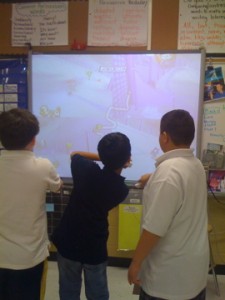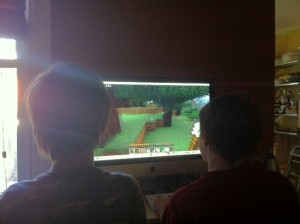 In 2010, I began experimenting with gaming in my classroom.
In 2010, I began experimenting with gaming in my classroom.
In my Grade Six classroom, ‘play’ wasn’t just about learning the facts and materials, but about creating an environment where they were most comfortable. Using Wii Olympics to have students virtually play participate in Luge or skiing events and then write down, sort, compare and analyze their scores helped them see an authentic reason why we sort data. Watching the little JK students exercise for 15 minutes a day using Wii Fit or Wii Sports (on those freezing cold mornings) was fascinating. Using NikeRemote on our shoes, we used game to track distances when we ran 3 times per week to reach our marathon goal. I was only beginning to discover the potential for gaming and learning. Connecting our games with classrooms across the world was the most fun. Skype spelling and math games was an awesome way to end our week. For me it really isn’t about the game itself, but about engaging my students. They identified with gaming. It was my way to capture them, when we couldn’t explore outside, or build ‘hands-on’.
Both Zack and Shawn, future TechEd leaders from Brock University (also students of mine) contemplate educational theories and structures by examining the idea of gamification of learning. In his blog, Zach wonders,
“Imagine if we could give students a lesson they could take home and play? If they enjoyed the lesson they would be more apt to practice the material. They could share it with friends and interact with people in their class online”.
Shawn then makes a profound realization,
“It occurs to me now that my prejudice towards gaming was based on the belief that games were based solely on fun, and so in turn their educational usefulness must be minimal. How silly that was to assume that kids have to feel or even know that they’re being taught in order to learn something”.
Shawn and Zack ‘s posts compelled me to ask my two boys (ages 9 and 11) if they saw any educational value in games (minecraft, wii, kinect) in the classroom or for their own learning. Their answer: No way. It is just for fun.
They have not made the connection between learning and play. I wonder if their definition of “learning” comes from their short experience with an established deep rooted system that still sees learning in a very traditional way. Sitting at a desk, direct instruction, preparing for tests, group activities, writing tests, memorizing facts, studying…
 And yet, on this very Saturday morning, as I read through the blog posts, my eyes wonder. I watch my boys plant crops near water, discussing a location that optimisms sun. I listen to them talk about the best way to ‘make’ paper so they can create books to put on the shelves that they created for the school that they designed. I listen to them talk about the formula needed to make ‘ink’ for their pens…….and then I spy, as they use they internet to find out facts about ink, paper mills and sugar. Then my 9 year old says…lets make a cake. They were using Minecraft.
And yet, on this very Saturday morning, as I read through the blog posts, my eyes wonder. I watch my boys plant crops near water, discussing a location that optimisms sun. I listen to them talk about the best way to ‘make’ paper so they can create books to put on the shelves that they created for the school that they designed. I listen to them talk about the formula needed to make ‘ink’ for their pens…….and then I spy, as they use they internet to find out facts about ink, paper mills and sugar. Then my 9 year old says…lets make a cake. They were using Minecraft.
My eyes wonder to their unopened packpacks. I wonder, what homework they have.
But, as they see it…it is play, not learning. So how do we connect the two? I think that both Shawn and Zack clearly make the point that there may be link between learning and engagement. But, maybe its something more? Do these games also help us with our critical senses? Do they encourage us to talk and problem solve? Do they encourage more divergent ways of thinking?
I certainly do not fully understand the impact that gaming is having on my own children, but by reading about the projects and innovations that a few teachers are ‘action’ researching, my confidence in the use of the methods has definitely heightened.
Joel Levin, a high school teacher discusses his first days of school: – http://minecraftteacher.net/
So, instead, for the first class we’ll talk about:
What kind of world they will want to play in.
What kind of gaming experience they desire and what they’d like to accomplish.
And I’ll try to figure out what other auxiliary projects they want to try while playing the game. Such as writing projects, making Let’s Play videos, modding the game… or who knows! I’m sure they will surprise me!
It is very reassuring that in spite of tradition and set curriculum, teachers are still finding ways to incorporate new mediums into the classroom. Thank you Shawn and Zack for deepening my thinking on this issue.


That’s fantastic! I would love to incorporate games into the classroom. I really like how ‘fun’ and ‘learning’ are perceived as two very different things by kids. I guess sneaking learning into game-play is sort of like sneaking vegetables into yummy foods.
Em
Zoe,
You’ve hit upon a great love of mine – despite the fact that I’m TERRIBLE at playing video games. Your kids are similar to my kids. They possibly learn more from playing Terraria, Pokemon and Moshi Monsters than they do some days at school. Sometimes my kids realize it’s learning and sometimes they don’t. I’ve created another blog that’s devoted to noting the gaming my family does at home, not because I’m conducting an educational experiment on them (I do worry about schools co-opting games and turning them into something less-fun) but because I want to change the perception that Shawn had but no longer subscribes to that gaming is a waste of time. familygamingxp.blogspot.com collects some of the amazing things my family’s said and done because of games. Like you, my wandering eyes examine the awesome things happening right around me that shows that learning happens even when people don’t realize it. Is it important to get them to realize it? I’m on the fence about that, but I’ll continue to contemplate it – while I get my behind handed to me in Mario Kart.
“I wonder if their definition of ‘learning’ comes from their short experience with an established deep rooted system that still sees learning in a very traditional way.”
That issue extended until recently to myself as well, yet now this notion of a sort of “stealth teaching” intrigues me. Obviously a teacher is still needed to guide students through the specifics of a lesson, but to what extent will it simply be pointing out the obvious? Your sons were demonstrating considerable ingenuity in their quest to make paper, and its this self-motivating, collaborative goal-oriented environment that gets me so excited about gaming’s role in a classroom.
Thanks for the recognition Zoe.
I liked your post. I have used strategy games to teach procedural writing and executive functions with students in the past. I have also played role playing games with junior and intermediate students; however, any exploration of using games in education must explore the negative elements. I think you need to spend more time exploring what critics of this approach would argue. I suggest 2 courses of action: 1) A bit of shameless self promotion – read my blog post at http://tuckerteacher.wordpress.com/2011/05/12/educational-video-games-what-do-they-undo/ and 2) read about how busniess are approaching using games to drive consumer responces to their brands…is using games at school at kind of skinner box, setting students up to be good consumers after they graduate?
Thanks for the reply Patrick. I loved your blog and resonated strongly with what you say about what we might be sacrificing when using new educational pedagogues such as gaming. I did respond to your blog.
Zoe
Thanks for the comment Shawn and for beginning to think deeply about how education pedagogy might be changing.
It is important however, to take a very serious look at a variety of opinions. I read and commented on http://tuckerteacher.wordpress.com/2011/05/12/educational-video-games-what-do-they-undo/#comment-110 myself. I wonder what you think of the questions posed by Patrick.
Diana,
You are one of the gaming pioneers. I didn’t even know what MMORG was until you blurted it out so impressively and with so much passion during the web 2.0 playoffs last march. I am so inspired that there are educators out there willing to risk new pedagogies as a way of bringing the love of learning to a more diverse group of students.
I look forward to following your work in this area Diana.
Zoe
Thanks for the comment Emily.
I can’t stop thinking about the “sneaking vegetables into yummy foods” analogy. It is perfect!
As a teacher-to-be, I wonder how quickly I can leap into gaming as an educational resource. I would much prefer to use games wherever possible, but I wonder if I’d need a benchmark ahead of time to be able to gauge the engagement / education balance. I imagine that with an active assessment method during the exercise, I’ll be able to gauge whether or not the lesson is successful; but without an experienced feel for learning expectations within the unit, I won’t know whether the progress made during the class will keep pace with the unit. Of course, the only resource I saw used was math circus as an enrichment tool/reward (without any feedback / assessment on the logic skills offered) so I’ve had limited exposure. Do you have any advice on how you confirm that the engagement / entertainment / education remains in balance? Also, is it better to reflect on the gaming and translate it to a lesson within the same period, or is it better to offer a brief summary with discussions to follow next class?
As always, thanks for popping by my blog.
Zoe, may I comment on Roy’s comment?
Certain phrases in his comment make me a little nervous: benchmark / assessment / learning expectations. As with Zoe’s initial example with her sons and Minecraft, she didn’t set out the goals of the task and judge her sons on their performance. They did that of their own accord. In our schools and the way they currently work, we’re not at the stage where the students have as much say, but with differentiated learning, there are attempts to move it in that direction.
Roy asked if anyone had advice on balancing engagement / entertainment / education with games, and whether it is better to reflect on the game and turn it into a lesson or summarize then discuss. I’m still working on the first and working hard to make sure both arenas – education and gaming – aren’t compromised or harmed by the other. As for the second, who’s doing the reflection? Who’s doing the summary? If Zoe permits it, I’ll write about how I used a video game with a lesson I designed – but it was the students that did the thinking, the connecting, and the reflecting, and I can share both the lesson plan and the results of that experience.
Hey, Mrs.Pipe
It’s Brianne, I started a new science site on edublogs and I was wondering if you can help me get more viewers?
Heres the site address: http://nasasciencegirl.edublogs.org/
Ps. My grade 8 year s going really good plus I’ve improved in Math alot!!
Thanks!!
From: Brianne